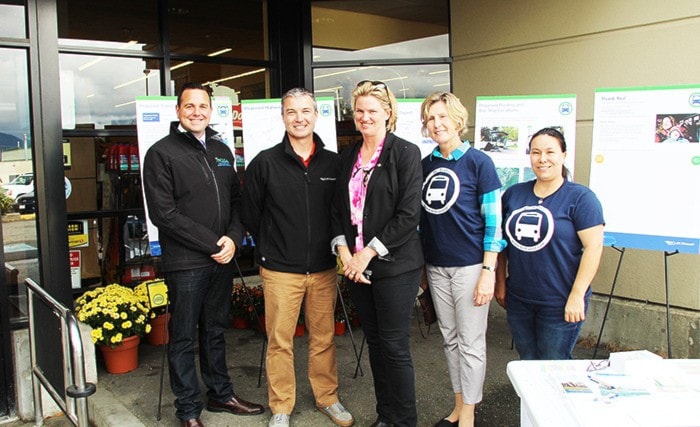As BC Transit consultations with the public kept Safeway shoppers engaged at the front of the store last Wednesday afternoon, senior regional transit manager Chris Fudge elaborated on some of the finer aspects of the Highway 16 Transportation Action Plan among municipal leaders.
“We’re getting a sense of what days people want to travel, so the idea is that this service is really connecting people to their nearest regional centre,” said Fudge.
“Their reasons for travel could be recreation, it could be medical, it could be social, so I think everybody’s going to have a different idea of what day of the week they want to travel.”
The buses that will be travelling to and from Prince Rupert and Terrace (just one route of four along Highway 16 between Prince Rupert and Prince George) will most likely be the same style of bus found in B.C. communities, called a light-duty bus, said Fudge, and can seat 20 passengers and are accessible for travellers with wheelchairs and other disabilities.
“This service is not intended to be a long haul service. We’re not a long haul service provider – our buses are not equipped for that kind of service. It’s really about getting people to that [regional centre] on same day travel and then returning back home,” he said, which is something that BC Transit’s research suggested was most needed in the northern communities.
When one bus is travelling between one route (Prince Rupert-Terrace for example), there might be another bus on an alternating day that travels the next route (Terrace-Hazelton Area). The affordable service is intended to complement long distance options like Greyhound, Northern Health and VIA Rail travel options instead of replacing or competing with them.
The public could choose which days of the week work best for them for a round-trip schedule involving buses that leave Prince Rupert at 9:35 a.m. and 5:10 p.m. and two buses leaving Terrace at 7:05 a.m. and 2:40 p.m. on the same day.
The province has provided $800,000 in funding over three years in a cost-share arrangement with municipalities along the corridor and Prince Rupert Mayor Lee Brain said some feedback will need to be gathered from the public when evaluating how much money will need to be spent from the city’s coffers.
“The cities themselves along the line are going to be chipping in for their particular areas, so at one point we’re going to need to talk to the public and say ‘Are you OK with a certain amount of our budget going to the buses?”. We’re still going to find out what those costs are going to be and they’re still in very early phases of that, but ultimately it will require partnership,” said Brain, adding that memorandums of understanding (MOUs) have been signed between the municipalities such as Prince Rupert, Port Edward and the province.
“So far though, the feedback seems pretty positive. Everybody wants this to happen.”
As recently as last month, the mayor explained he and his fiancèe were driving near Hazelton and saw two young women hitchhiking at night, a phenomenon derided for decades as dangerous and risky.
“Us to Terrace, we can analyze what the needs are there, but there’s still lots of hitchhikers. It would probably save a lot of lives [in the smaller and more close together communities like the Hazelton area],” he said.
North Coast MLA Jennifer Rice, praised the process as a step in the right direction, but criticized the lack of advertisement for the consultation period and the awkward place it puts some of the townships along the corridor.
“It’s an unfair burden to a lot of municipalities and a lot of really small communities. It’s not like Vancouver where there’s a huge tax base. So the notion is very good, but it’s not sustainable,” she said.
“Three years of funding – what happens after three years? No matter what the City of Prince Rupert contributes now, it’s highly unlikely that we’re going to be in a state of tremendous prosperity where they can fund the whole amount.”
Rice added that this solution was the top recommendation coming out of the 2006 Highway of Tears symposium and out of B.C.’s Missing Women Commission of Inquiry, led by Wally Oppal.
Residents looking to add their voice can do so until Sept. 16 through the survey at www.bctransit.com/highway16
